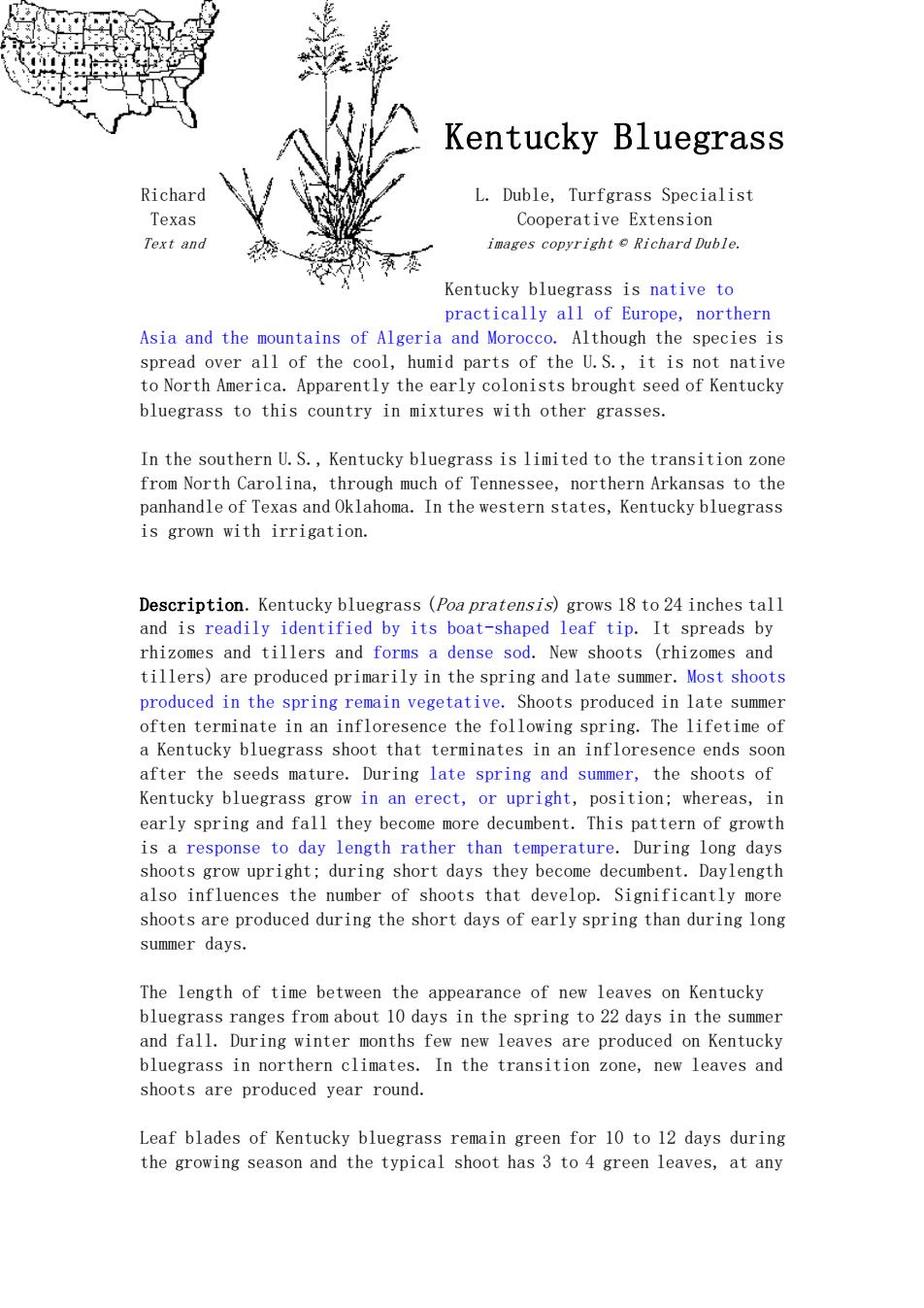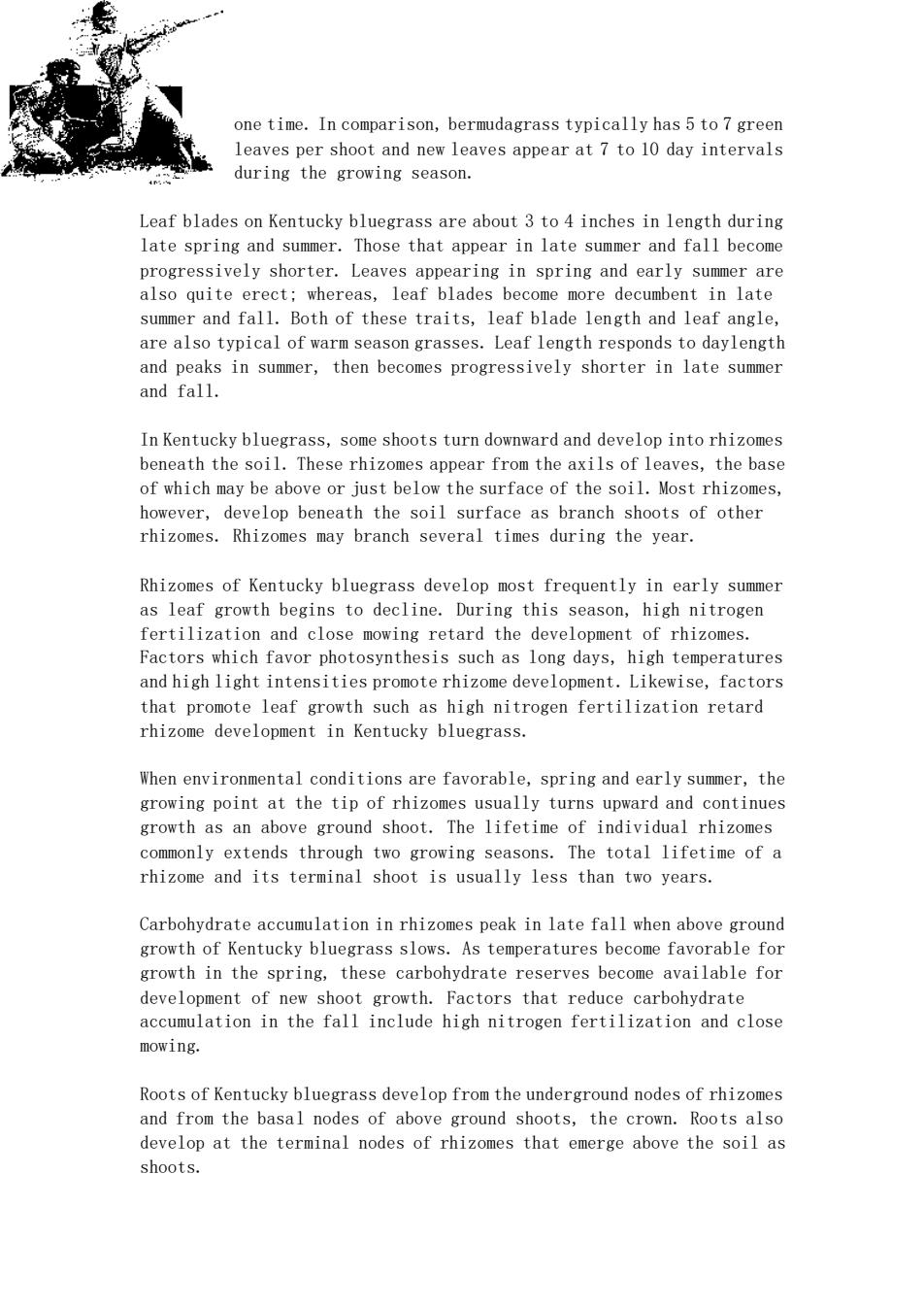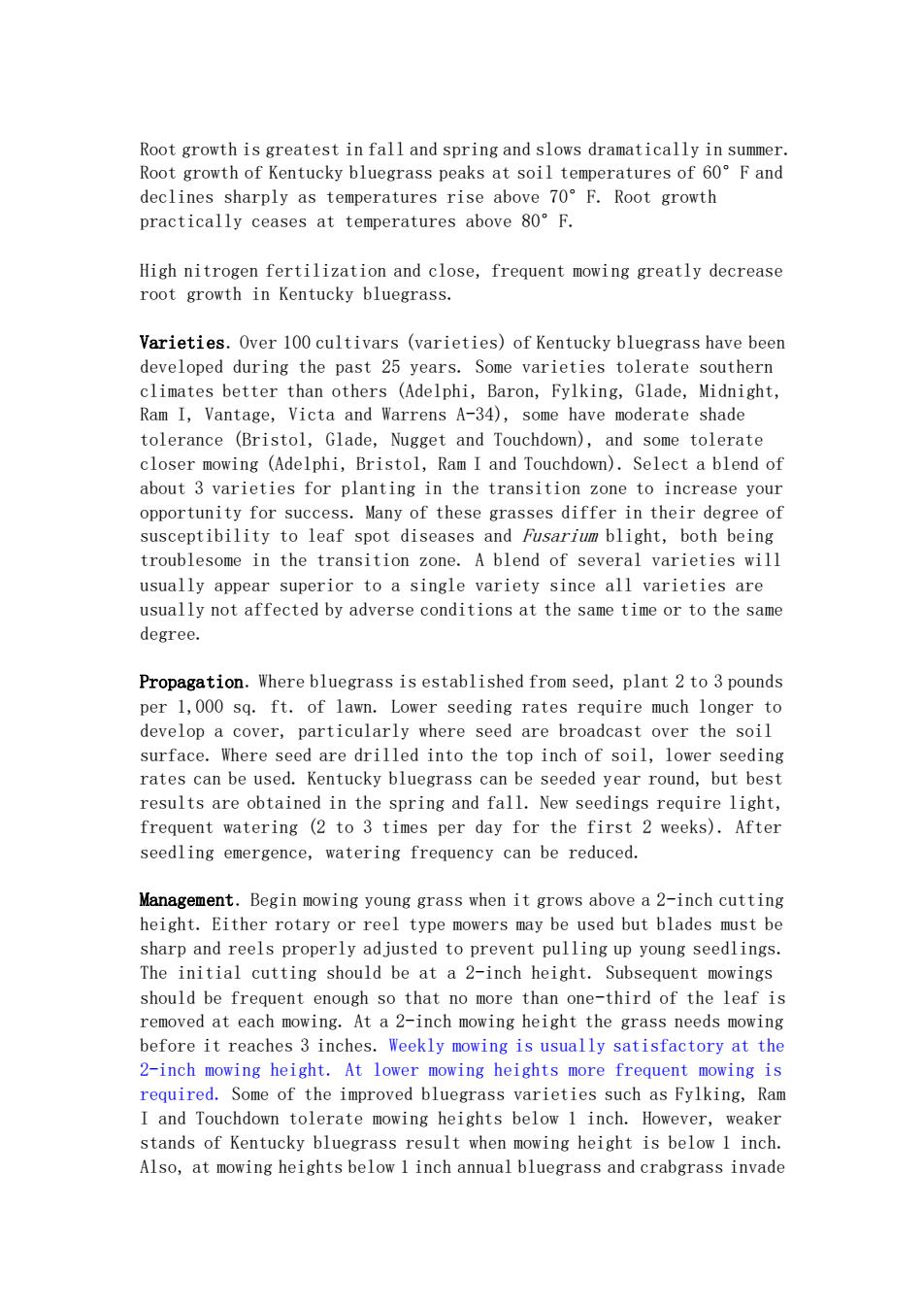
Kentucky Bluegrass Richard L.Duble,Turfgrass Specialist Texas Cooperative Extension Text and images copyright c Richard Duble. Kentucky bluegrass is native to practically all of Europe,northern Asia and the mountains of Algeria and Morocco.Although the species is over all of the co humid parts of the U.S. it is not nativ merica.Apparently the earlycooistsbrou sed bluegrass to this country in mixtures with other grasses. In the southern U.s..kentucky bluegrass is limited to the transition zone from North Carolina,th nor the as to the panhandle ofT is grown with irrigation. egra ss (po sis s18 to24 inches tall dentifie a pra d by its boat-shap ped lear tip. spreads by rhizomes and tillers and forms a dense sod.New shoots (rhizomes and tillers)are produced primarily in the spring and late summer.Most shoots produced in the spring remain vegetative.Shoots produced in late summer often terminate in an inflorese ce the following sp pring.The lifetime of a Kentucky blue nce ends after the seeds mature.During late spring and summer,the shoots of Kentucky bluegrass grow in an erect,or upright,position;whereas,in early spring and fall they become more decumbent.This pattern of growth is a response to day length rather than tempe erature.During long days shoots gr upright:duri short days they Daylength also influences the number of hoots that develop.Significantly more shoots are produced during the short days of early spring than during long summer days. The length of time betwee eof new 1 on Kentucky ss ranges from about 10 days in the spring to 22 days in the summe and fall.During winter months few new leaves are produced on Kentucky bluegrass in northern climates.In the transition zone,new leaves and shoots are produced year round. Leaf blades of Kentucky bluegrass main green for 10 to 12 days during the growing season and the typical shoot has 3 to 4 green leaves,at any
Kentucky Bluegrass Richard L. Duble, Turfgrass Specialist Texas Cooperative Extension Text and images copyright © Richard Duble. Kentucky bluegrass is native to practically all of Europe, northern Asia and the mountains of Algeria and Morocco. Although the species is spread over all of the cool, humid parts of the U.S., it is not native to North America. Apparently the early colonists brought seed of Kentucky bluegrass to this country in mixtures with other grasses. In the southern U.S., Kentucky bluegrass is limited to the transition zone from North Carolina, through much of Tennessee, northern Arkansas to the panhandle of Texas and Oklahoma. In the western states, Kentucky bluegrass is grown with irrigation. Description. Kentucky bluegrass (Poa pratensis) grows 18 to 24 inches tall and is readily identified by its boat-shaped leaf tip. It spreads by rhizomes and tillers and forms a dense sod. New shoots (rhizomes and tillers) are produced primarily in the spring and late summer. Most shoots produced in the spring remain vegetative. Shoots produced in late summer often terminate in an infloresence the following spring. The lifetime of a Kentucky bluegrass shoot that terminates in an infloresence ends soon after the seeds mature. During late spring and summer, the shoots of Kentucky bluegrass grow in an erect, or upright, position; whereas, in early spring and fall they become more decumbent. This pattern of growth is a response to day length rather than temperature. During long days shoots grow upright; during short days they become decumbent. Daylength also influences the number of shoots that develop. Significantly more shoots are produced during the short days of early spring than during long summer days. The length of time between the appearance of new leaves on Kentucky bluegrass ranges from about 10 days in the spring to 22 days in the summer and fall. During winter months few new leaves are produced on Kentucky bluegrass in northern climates. In the transition zone, new leaves and shoots are produced year round. Leaf blades of Kentucky bluegrass remain green for 10 to 12 days during the growing season and the typical shoot has 3 to 4 green leaves, at any

one time.In comparison,bermudagrass typically has 5 to 7 green leaves pe er shoot and new leaves appear at 7 to 10 day intervals during the growing season Leaf blades on Kentucky bluegrass are about 3 to 4 inches in length during late spring and summer.Those that appear in late summer and fall become 。Ids u!u!eaddp saa4.IoDe er whereas leaf blades more de cum in late summer and fall.Both of these traits,leaf blade length and leaf angle are also typical of warm season grasses.Leaf length responds to daylength and peaks in summer,then becomes progressively shorter in late summer and fall. In Kentucky bluegrass,some shoots turn downward and develop into rhizomes beneath the soil.These rhizomes appear from the axils of leaves,the base of which may be above or just below the surface of the soil.Most rhizomes, however.develop beneath the soil surface as branch shoots of other rhizomes.Rhizomes may branch several times during the year. Rhizomes of Kentucky bluegrass develop most frequently in early summer as leaf growth begins to decline.During this season,high nitrogen fertilization and close mowing retard the development of rhizomes. Factors which favor photosynthesis such as long days,high temperatures and high light intensities promote rhizome development.Likewise,fact that promote leaf growth such as high nitrogen fertilization retard rhizome development in kentucky bluegrass. When environmental conditions are favorable,spring and early summer,the growing point at the tip of rhizomes usually ward and continues growth as an above ground shoot.The lifetime of individual rhizomes commonly extends through two growing seasons.The total lifetime of a rhizome and its terminal shoot is usually less than two years. Carbohydrate accumulation in rhizomes peak in late fall when above ground growth of Kentucky bluegrass slows As temperatures become favorable for growth in the spring,these carbohydrate reserves become available for development of new shoot growth.Factors that reduce carbohydrate accumulation in the fall include high nitrogen fertilization and close mowing. Roots of Kentucky bluegrass develop from the underground nodes of rhizomes and from the basal nodes of above ground shoots,the crown.Roots also develop at the terminal nodes of rhizomes that emerge above the soil as shoots
one time. In comparison, bermudagrass typically has 5 to 7 green leaves per shoot and new leaves appear at 7 to 10 day intervals during the growing season. Leaf blades on Kentucky bluegrass are about 3 to 4 inches in length during late spring and summer. Those that appear in late summer and fall become progressively shorter. Leaves appearing in spring and early summer are also quite erect; whereas, leaf blades become more decumbent in late summer and fall. Both of these traits, leaf blade length and leaf angle, are also typical of warm season grasses. Leaf length responds to daylength and peaks in summer, then becomes progressively shorter in late summer and fall. In Kentucky bluegrass, some shoots turn downward and develop into rhizomes beneath the soil. These rhizomes appear from the axils of leaves, the base of which may be above or just below the surface of the soil. Most rhizomes, however, develop beneath the soil surface as branch shoots of other rhizomes. Rhizomes may branch several times during the year. Rhizomes of Kentucky bluegrass develop most frequently in early summer as leaf growth begins to decline. During this season, high nitrogen fertilization and close mowing retard the development of rhizomes. Factors which favor photosynthesis such as long days, high temperatures and high light intensities promote rhizome development. Likewise, factors that promote leaf growth such as high nitrogen fertilization retard rhizome development in Kentucky bluegrass. When environmental conditions are favorable, spring and early summer, the growing point at the tip of rhizomes usually turns upward and continues growth as an above ground shoot. The lifetime of individual rhizomes commonly extends through two growing seasons. The total lifetime of a rhizome and its terminal shoot is usually less than two years. Carbohydrate accumulation in rhizomes peak in late fall when above ground growth of Kentucky bluegrass slows. As temperatures become favorable for growth in the spring, these carbohydrate reserves become available for development of new shoot growth. Factors that reduce carbohydrate accumulation in the fall include high nitrogen fertilization and close mowing. Roots of Kentucky bluegrass develop from the underground nodes of rhizomes and from the basal nodes of above ground shoots, the crown. Roots also develop at the terminal nodes of rhizomes that emerge above the soil as shoots

Root growth is g ratest in fall and spring and slows dramatically in summo Root t soil to declines shply temperatores rise above entucky bluegrass peaks at practically ceases at temperatures above 80 F. High nitrogen fertilization and close,frequent mowing greatly decrease root growth in Kentucky bluegrass Varieties.Over 100 cultivars (varieties)of Kentucky bluegrass have been developed during the past 25 years.Some varieties tolerate southern climates better than others (Adelphi,Baron,Fylking,Glade,Midnight Ram I,Vantage,Victa and Warrens A-34),some have moderate shade tolerance (Br tol Glade,Nugge and Touchdown),and some tolerate closer mowing (Adelphi,Bristol,Ram I and Touchdown).Select a blend of about 3 varieties for planting in the transition zone to increase your opportunity for success.Many of these grasses differ in their degree of susceptibility to leaf spot diseases and Fusarium blight,both being troublesome in the transition zone. A blend of several varieties will usually appear superior to a single variety since all varieties are usually not affected by adverse conditions at the same time or to the same degree. istabedro Lower seeding rates require much longer develop a cover,particularly where seed are broadcast over the soil surface.Where seed are drilled into the top inch of soil,lower seeding rates can be used.Kentucky bluegrass can be seeded year round,but best results are obtained in the spring and fall.New seedings require light, frequent watering (2 to 3 times per day for the first 2 weeks).Afte seedling emergence,watering frequency can be reduced. Management.Begin mowing young grass when it grows above a 2-inch cutting height.Either rotary or reel type mowers may be used but blades must be and reels operly adjusted to ent pulling young seedlings The initial cutting should be at a 2-inch height.Subsequent mowings should be frequent enough so that no more than one-third of the leaf is removed at each mowing.At a 2-inch mowing height the grass needs mowing before it reaches 3 inches.Weekly mowing is usually satisfactory at the 2-inch mowing height.At lower mowing heights more frequent mowing is required. ome of the improved bluegrass varieties such as Fylking,Ram I and Touchdown tolerate mowing heights below 1 inch.However,weaker stands of Kentucky bluegrass result when mowing height is below 1 inch. Also,at mowing heights below 1 inch annual bluegrass and crabgrass invade
Root growth is greatest in fall and spring and slows dramatically in summer. Root growth of Kentucky bluegrass peaks at soil temperatures of 60°F and declines sharply as temperatures rise above 70°F. Root growth practically ceases at temperatures above 80°F. High nitrogen fertilization and close, frequent mowing greatly decrease root growth in Kentucky bluegrass. Varieties. Over 100 cultivars (varieties) of Kentucky bluegrass have been developed during the past 25 years. Some varieties tolerate southern climates better than others (Adelphi, Baron, Fylking, Glade, Midnight, Ram I, Vantage, Victa and Warrens A-34), some have moderate shade tolerance (Bristol, Glade, Nugget and Touchdown), and some tolerate closer mowing (Adelphi, Bristol, Ram I and Touchdown). Select a blend of about 3 varieties for planting in the transition zone to increase your opportunity for success. Many of these grasses differ in their degree of susceptibility to leaf spot diseases and Fusarium blight, both being troublesome in the transition zone. A blend of several varieties will usually appear superior to a single variety since all varieties are usually not affected by adverse conditions at the same time or to the same degree. Propagation. Where bluegrass is established from seed, plant 2 to 3 pounds per 1,000 sq. ft. of lawn. Lower seeding rates require much longer to develop a cover, particularly where seed are broadcast over the soil surface. Where seed are drilled into the top inch of soil, lower seeding rates can be used. Kentucky bluegrass can be seeded year round, but best results are obtained in the spring and fall. New seedings require light, frequent watering (2 to 3 times per day for the first 2 weeks). After seedling emergence, watering frequency can be reduced. Management. Begin mowing young grass when it grows above a 2-inch cutting height. Either rotary or reel type mowers may be used but blades must be sharp and reels properly adjusted to prevent pulling up young seedlings. The initial cutting should be at a 2-inch height. Subsequent mowings should be frequent enough so that no more than one-third of the leaf is removed at each mowing. At a 2-inch mowing height the grass needs mowing before it reaches 3 inches. Weekly mowing is usually satisfactory at the 2-inch mowing height. At lower mowing heights more frequent mowing is required. Some of the improved bluegrass varieties such as Fylking, Ram I and Touchdown tolerate mowing heights below 1 inch. However, weaker stands of Kentucky bluegrass result when mowing height is below 1 inch. Also, at mowing heights below 1 inch annual bluegrass and crabgrass invade

a bluegrass turf.At mowing heights above 1inches weeds are much less em Compared to the war season grasses,Kentucky bluegrass has a high ater requirement.As much as 2 inches of water per week are needed to keep bluegrass green and growing during summer months in the transition zone. Ideally this amount of water would be applied in one day to wet the entire otzone is often too shallow to hold that amount of waterM inch of water should be applied on any single day to promote deeper rooting of the bluegrass turf Where bluegrass is allowed to go dormant during drought periods,as little as inch of water every 2 to 3 weeks will keep the crowns of the grass alive.Then,after rainfall or significant irrigation the grass will quickly recover.The drought resistance of Kentucky bluegrass is generally underestimated.Bluegrass can survive several months without significant rainfall or irrigation. Nitrogen requirements of Kentucky bluegrass are much higher during the ear than during subsequent years.The grass will respond to 5 to 6 pounds of nitrogen the first year:whereas,2 to 3 pounds are adequate for maintenance after the first vear.During summer months Kentucky bluegrass will burn if too much soluble nitrogen is applied at one time or if it is not watered in immediately after application.no more than ound of soluble nitrogen per 1,000 sq. ft. hould be applied in one application.Slow release nitrogen sources can be applied in larger amounts and less frequentIy. In alkaline soils Kentucky bluegrass often develops iron chlorosis,a vellowing between the veins of young actively growing leaves Color car be quickly restored with a foliar application of ferrous sulfate at 2 oz. per 1,000 sg.ft.or another iron source at recommended rates.Iron chlorosis is aggravated by high levels of phosphorus in the soil.Where iron chlorosis is a problem,phosphorus fertilization should be kept to a minimum. Weed,Pest and Disease Management.Annual bluegrass(P.annua),crabgrass, dandelions and clover are major weed problems in Kentucky bluegrass turf. The annual grasses can be effectively controlled with timely applications of preemerge herbicides.the broadleaved weeds are effectively controlled with hormone type herbicides Insects including white grubs,billbugs and sod webworms can destroy plantings of bluegrass.Insect populations should be monitored so that timely insecticide applications can be made.Pest management in this
a bluegrass turf. At mowing heights above 1° inches weeds are much less of a problem. Compared to the warm season grasses, Kentucky bluegrass has a high water requirement. As much as 2 inches of water per week are needed to keep bluegrass green and growing during summer months in the transition zone. Ideally this amount of water would be applied in one day to wet the entire rootzone of the turf. However, the effective rootzone is often too shallow to hold that amount of water. No less than ° inch of water should be applied on any single day to promote deeper rooting of the bluegrass turf. Where bluegrass is allowed to go dormant during drought periods, as little as ° inch of water every 2 to 3 weeks will keep the crowns of the grass alive. Then, after rainfall or significant irrigation the grass will quickly recover. The drought resistance of Kentucky bluegrass is generally underestimated. Bluegrass can survive several months without significant rainfall or irrigation. Nitrogen requirements of Kentucky bluegrass are much higher during the establishment year than during subsequent years. The grass will respond to 5 to 6 pounds of nitrogen the first year; whereas, 2 to 3 pounds are adequate for maintenance after the first year. During summer months Kentucky bluegrass will burn if too much soluble nitrogen is applied at one time or if it is not watered in immediately after application. No more than ° pound of soluble nitrogen per 1,000 sq. ft. should be applied in one application. Slow release nitrogen sources can be applied in larger amounts and less frequently. In alkaline soils Kentucky bluegrass often develops iron chlorosis, a yellowing between the veins of young actively growing leaves. Color can be quickly restored with a foliar application of ferrous sulfate at 2 oz. per 1,000 sq. ft. or another iron source at recommended rates. Iron chlorosis is aggravated by high levels of phosphorus in the soil. Where iron chlorosis is a problem, phosphorus fertilization should be kept to a minimum. Weed, Pest and Disease Management. Annual bluegrass (P. annua), crabgrass, dandelions and clover are major weed problems in Kentucky bluegrass turf. The annual grasses can be effectively controlled with timely applications of preemerge herbicides. The broadleaved weeds are effectively controlled with hormone type herbicides. Insects including white grubs, billbugs and sod webworms can destroy plantings of bluegrass. Insect populations should be monitored so that timely insecticide applications can be made. Pest management in this

manner is much more cost effective than either routine insecticide applications or replanting large areas of bluegrass turf. Maior diseases of bluegrass turf in the transition zone include fusarium. Helmintho porium leaf spot diseas rust and powdery mildew.Selecting blends of Kentucky bluegrass with different degrees of resistance to these diseases is one means of control.Overseeding bluegrass turf with perennial rvegrass or planting mixtures of bluegrass and rvegrass provides a good of a disease which causes a bleaching of leaves and severe rotting of roots
manner is much more cost effective than either routine insecticide applications or replanting large areas of bluegrass turf. Major diseases of bluegrass turf in the transition zone include Fusarium, Helminthosporium leaf spot diseases, rust and powdery mildew. Selecting blends of Kentucky bluegrass with different degrees of resistance to these diseases is one means of control. Overseeding bluegrass turf with perennial ryegrass or planting mixtures of bluegrass and ryegrass provides a good suppresion of Fusarium blight, a disease which causes a bleaching of leaves and severe rotting of roots